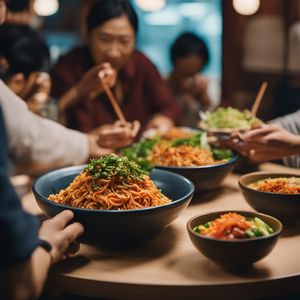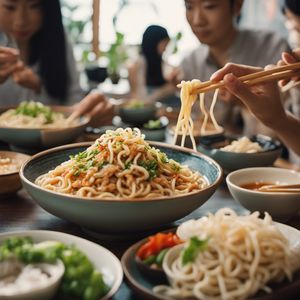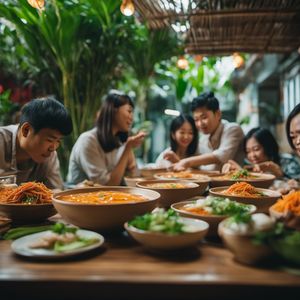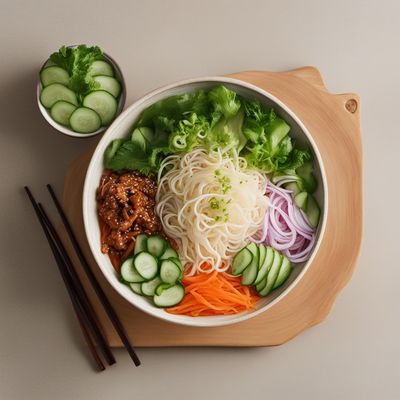
Dish
Jaengban guksu
The dish consists of thin wheat noodles that are cooked and then chilled. The noodles are then topped with a variety of vegetables such as cucumber, carrot, and radish. The spicy sauce is made with gochujang (Korean chili paste), vinegar, sugar, and sesame oil. The dish is typically garnished with sliced egg and sesame seeds.
Origins and history
Jaengban guksu is a popular Korean dish that is believed to have originated in the city of Pyongyang. It is often served during the summer months as a refreshing and cooling meal.
Dietary considerations
This dish is suitable for vegetarians and vegans as it does not contain any meat or animal products. However, it is not suitable for those who are gluten intolerant as it contains wheat noodles.
Variations
There are many variations of this dish, some of which include adding sliced beef or chicken to the noodles. Some people also like to add pear or apple to the sauce to give it a slightly sweet flavor. Others like to add different types of vegetables to the dish such as lettuce or spinach.
Presentation and garnishing
Jaengban guksu is typically served on a large platter with the noodles arranged in a circular pattern. The vegetables are then arranged on top of the noodles and the sauce is drizzled over the top. The dish is often garnished with sliced egg and sesame seeds.
Tips & Tricks
When making the sauce, be sure to adjust the amount of gochujang to your liking. If you prefer a milder sauce, use less gochujang. If you prefer a spicier sauce, use more gochujang. You can also add a splash of soy sauce to the sauce for a bit of umami flavor.
Side-dishes
Jaengban guksu is typically served as a main course and is often accompanied by a side of kimchi or pickled vegetables. Some people also like to serve it with a side of rice or a cold beer.
Drink pairings
This dish pairs well with a light beer or a crisp white wine such as Riesling. It is also delicious with a cold glass of iced tea.
Delicious Jaengban guksu recipes
More dishes from this category... Browse all »

Abura soba
Japanese cuisine

Ants Climbing a Tree
Chinese cuisine

Asahikawa ramen
Japanese cuisine

Biangbiang Noodles
Chinese cuisine

Bibim guksu
Korean cuisine

Bukkake udon
Japanese cuisine

Burnt Miso Ramen
Japanese cuisine

Bánh canh
Vietnamese cuisine



